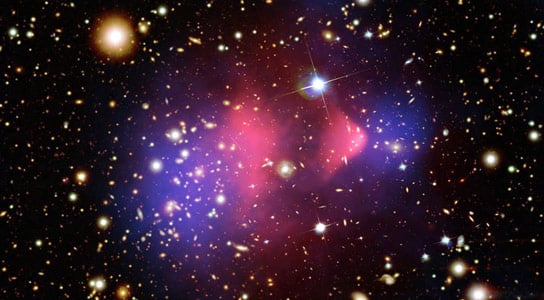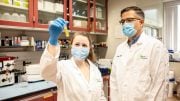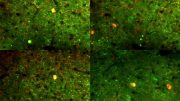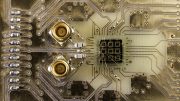
The Cryogenic Dark Matter Search (CDMS) experiment is one of several major international collaborations that has been searching for dark matter since 2003. The experiment uses very sophisticated detector technology and advanced analysis techniques to enable cryogenically cooled (almost absolute zero temperature at -460 degrees F) germanium and silicon targets to search for the rare recoil of dark matter particles. Credit: Texas A&M University
SuperCDMS researchers have for the first time observed a concrete hint of a weakly interacting massive particle (WIMP), the particle physicists believe to be behind dark matter.
College Station — An international collaboration whose search for dark matter is powered by detectors being fabricated at Texas A&M University has for the first time observed a concrete hint of what physicists believe to be the particle behind dark matter and therefore nearly a quarter of the universe — a WIMP, or weakly interacting massive particle.
Scientists with the international Super Cryogenic Dark Matter Search (SuperCDMS) experiment involving Texas A&M high-energy physicist Rupak Mahapatra are reporting a WIMP-like signal at the 3-sigma level, indicating a 99.8 percent chance — or, in high-energy parlance, a hint of the mysterious substance dark matter that is believed to hold the cosmos together but to date has never been directly observed.
“In high-energy physics, a discovery is only claimed at 5-sigma or better,” Mahapatra said. “So this is certainly very exciting, but not fully convincing by the standards. We just need more data to be sure. For now, we have to live with this tantalizing hint of one of the biggest puzzles of our time.”
SuperCDMS researchers are announcing their breakthrough result in talks around the nation, including one at noon today (Monday, April 15) by Mahapatra, a principal investigator in the collaboration and a member of the George P. and Cynthia Woods Mitchell Institute for Fundamental Physics and Astronomy. Mahapatra’s public presentation will be held in the Stephen W. Hawking Auditorium within the Mitchell Institute and streamed live via TTVN. The collaboration has detailed its full results in a paper, “Dark Matter Search Results Using the Silicon Detectors of CDMS II,” published in arXiv that eventually will appear in Physical Review Letters.
Notoriously elusive, WIMPs rarely interact with normal matter and therefore are difficult to detect. Scientists believe they occasionally bounce off, or scatter like billiard balls from, atomic nuclei, leaving behind a small amount of energy capable of being tracked by detectors deep underground, particle colliders such as the Large Hadron Collider at CERN and even instruments in space like the Alpha Magnetic Spectrometer (AMS) mounted on the International Space Station (ISS).
The CDMS experiment, located a half-mile underground at the Soudan mine in northern Minnesota and managed by the United States Department of Energy’s Fermi National Accelerator Laboratory, has been searching for dark matter since 2003. The experiment uses very sophisticated detector technology and advanced analysis techniques to enable cryogenically cooled (almost absolute zero temperature at -460 degrees F) germanium and silicon targets to search for the rare recoil of dark matter particles.
Mahapatra says the latest analysis represents comprehensive data gleaned from the largest exposure with silicon detectors during the CDMS-II operation, an earlier phase of the overall experiment involving more than 50 scientists from 18 international institutions.
“This result is from data taken a few years ago using silicon detectors manufactured at Stanford that are now defunct,” Mahapatra said. “Increased interest in the low mass WIMP region motivated us to complete the analysis of the silicon-detector exposure, which is less sensitive than germanium for WIMP masses above 15 giga-electronvolts [one GeVa is equal to a billion electron volts] but more sensitive for lower masses. The analysis resulted in three events, and the estimated background is 0.7 events.”
In addition to being heavily involved in the data analysis, Mahapatra says the Texas A&M group performed the crucial calibration of the silicon detectors, guaranteeing that the signal would look the same, regardless of which of the eight detectors located within the mine it might appear.
While Mahapatra says Monte Carlo simulations weren’t able to rule out statistical fluctuations as the cause of the backgrounds, the team believes said fluctuations would rarely produce a similar energy distribution, which they interpret instead as spin-independent scattering of WIMPs. And although he says the result is certainly encouraging and worthy of further investigation, he cautions it should not be considered a discovery.
“We are only 99.8 percent sure, and we want to be 99.9999 percent sure,” Mahapatra said. “At 3-sigma, you have a hint of something. At 4-sigma, you have evidence. At 5-sigma, you have a discovery.
“In medicine, you can say you are curing 99.8 percent of the cases, and that’s OK. When you say you’ve made a fundamental discovery in high-energy physics, you can’t be wrong. Given the money involved — $30 million in this case — it has to be extremely precise. With a 99.8 percent chance, that means if you repeat the same experiment a few hundred times, there is one chance it can go wrong. We want one out of a million instead.”
Using germanium detectors, the collaboration previously in 2010 reported detection of two events in the signal region and an estimated background of 0.9 events. They eventually concluded these events more likely were attributable to leakage of surface electrons rather than actual nuclear recoils.
6-inch detectors also being test-fabricated in Mahapatra’s lab for the Generation 3 (G3) experiments expected in a few years. These novel silicon detectors represent a world-first in cryogenic detection and are approximately 30 times more sensitive than the individual silicon detectors behind the SuperCDMS collaboration’s latest result. Credit: Texas A&M University
For the past four years, Mahapatra and his Texas A&M team — which includes his Department of Physics and Astronomy-based research group as well as collaborator Rusty Harris in the Department of Electrical Engineering — have been developing the larger, more advanced detectors needed for the project’s current phases, from SuperCDMS to the even more sophisticated GEODM (Germanium Observatory for Dark Matter) experiments. They are developing both germanium and silicon detectors to create dual-threat devices that are much bigger, better, and cheaper. He notes his laboratory’s new 6-inch (15-centimeter) diameter silicon detectors represent a world-first in cryogenic detection and are approximately 30 times more sensitive than the individual silicon detectors behind this latest result.
“The industrial manufacturing and fabrication facility we have set up here at Texas A&M has enabled us to bring down the cost from $350,000 to about $40,000 per kilogram ($160,000 to about $18,000 per pound),” Mahapatra said. “We also have a 90 percent success rate, versus the previous 20 percent rate for the original silicon and germanium devices.”
Mahapatra says the collaboration will continue to probe this WIMP sector using the SuperCDMS Soudan experiment’s operating germanium detectors and is considering using silicon detectors in future experiments.
References:
“Silicon Detector Dark Matter Results from the Final Exposure of CDMS II” by CDMS Collaboration: R. Agnese, Z. Ahmed, A.J. Anderson, S. Arrenberg, D. Balakishiyeva, R. Basu Thakur, D.A. Bauer, J. Billard, A. Borgland, D. Brandt, P.L. Brink, T. Bruch, R. Bunker, B. Cabrera, D.O. Caldwell, D.G. Cerdeno, H. Chagani, J. Cooley, B. Cornell, C.H. Crewdson, P. Cushman, M. Daal, F. Dejongh, E. Do Couto E Silva, T. Doughty, L. Esteban, S. Fallows, E. Figueroa-Feliciano, J. Filippini, J. Fox, M. Fritts, G.L. Godfrey, S.R. Golwala, J. Hall, R.H. Harris, S.A. Hertel, T. Hofer, D. Holmgren, L. Hsu, M.E. Huber, A. Jastram, O. Kamaev, B. Kara, M.H. Kelsey, A. Kennedy, P. Kim, M. Kiveni, K. Koch, M. Kos, S.W. Leman, B. Loer, E. Lopez Asamar, R. Mahapatra, V. Mandic, C. Martinez, K.A. McCarthy, N. Mirabolfathi, R.A. Moffatt, D.C. Moore, P. Nadeau, R.H. Nelson, K. Page, R. Partridge, M. Pepin, A. Phipps, K. Prasad, M. Pyle, H. Qiu, W. Rau, P. Redl, A. Reisetter, Y. Ricci, T. Saab, B. Sadoulet, J. Sander, K. Schneck, R.W. Schnee, S. Scorza, B. Serfass, B. Shank, D. Speller, K.M. Sundqvist, A.N. Villano, B. Welliver, D.H. Wright, S. Yellin, J.J. Yen, J. Yoo, B.A. Young, J. Zhang, 16 December 2013, Physical Review Letters.
DOI: 10.1103/PhysRevLett.111.251301
“Silicon detector results from the first five-tower run of CDMS II” by CDMS Collaboration: R. Agnese, Z. Ahmed, A.J. Anderson, S. Arrenberg, D. Balakishiyeva, R. Basu Thakur, D.A. Bauer, A. Borgland, D. Brandt, P.L. Brink, T. Bruch, R. Bunker, B. Cabrera, D.O. Caldwell, D.G. Cerdeno, H. Chagani, J. Cooley, B. Cornell, C.H. Crewdson, P. Cushman, M. Daal, F. Dejongh, P.C.F. Di Stefano, E. do Couto e Silva, T. Doughty, L. Esteban, S. Fallows, E. Figueroa-Feliciano, J. Filippini, J. Fox, M. Fritts, G.L. Godfrey, S.R. Golwala, J. Hall, R.H. Harris, S.A. Hertel, T. Hofer, D. Holmgren, L. Hsu, M.E. Huber, A. Jastram, O. Kamaev, B. Kara, M.H. Kelsey, A. Kennedy, P. Kim, M. Kiveni, K. Koch, M. Kos, S.W. Leman, E. Lopez-Asamar, R. Mahapatra, V. Mandic, C. Martinez, K.A. McCarthy, N. Mirabolfathi, R.A. Moffatt, D.C. Moore, P. Nadeau, R.H. Nelson, K. Page, R. Partridge, M. Pepin, A. Phipps, K. Prasad, M. Pyle, H. Qiu, W. Rau, P. Redl, A. Reisetter, Y. Ricci, T. Saab, B. Sadoulet ( and ), J. Sander, K. Schneck, R.W. Schnee, S. Scorza, B. Serfass, B. Shank, D. Speller, K.M. Sundqvist, A.N. Villano, B. Welliver, D.H. Wright, S. Yellin, J.J. Yen, J. Yoo, B.A. Young and J. Zhan, 27 August 2013, Physical Review D.
DOI: 10.1103/PhysRevD.88.031104
The collaboration’s work — beginning with CDMS and CDMS-II and continuing with SuperCDMS and GEODM — is funded by the DOE and the National Science Foundation as well as the Natural Sciences and Engineering Research Council of Canada (NSERC).
“In addition to NSF funding and an early career research award from the DOE, this work would not have been possible without start-up support from Texas A&M University and the College of Science and roughly $2 million in equipment from Maximum Integrated Products, Inc. (NASDAQ: MXIM) in Dallas,” Mahapatra said. “Additionally, the Mitchell Institute funds the postdoctoral fellow, Joel Sander, who is spearheading the effort to develop alternate next-generation detectors that are not only another order of magnitude cheaper and but can also run at easier cryogenic temperature, which is ideal for a ton-scale experiment on budget. The goal of this funding was to take up high-risk, high-return research that normally does not get supported by traditional funding from federal funding agencies like DOE and NSF.”









Almost never interacts, near zero Kelvin needed to id, sounds like ORMES
Orbitally rearranged monoatomic elements.
Because they have high spin, their nucleus is oval not round, and their valences do not interact, hence are undetectable to our instruments.
Science has been experimenting with this matter for over a 1/4 of a century. Super cooled they pair up as bosuns, and are Bose-Einstein condensate. It may be that our sun, during its delayed magnetic reversal where it has two of one pole, is producing more of this type of element.
More being able to be discovered by science?
Hi, Katesisco! Hope this finds you well!
In the first instance of your post, I wish to enlighten you with regard to the dogmatic assumption regarding ‘Matter’… ‘There is no such thing!’ It is, in my view the most misconceived posit ever put forward. We look around us and perceive what appears to be, ‘Solid Objects’ and yet, we know without doubt that such perception is nothing more than an illusion. (for the uninitiated)if a Proton was analogically applied to a house its Door Mat would be two hundred miles away (Proton/Electron configuration)). The very same misconception has, in my view grown up around the concept of ‘Matter’.
It is also, in my view, ‘Electromagnetic Energy’ that makes up not just our entire universe but ‘Infinity’ as well and the reason why we need to work in a ‘Cooled’ environment. (Such energy does not like heat!)
You further suggest that, ‘Science’ has been experimenting with this matter for over a quarter of a century and still they have yet to resolve the issues? ‘Could it be that this is because those involved have been applying ‘Wrong assumptions?’
‘Could it be that the the, magnetic reversal you note is the very reason why the particles are able to react the way they do ‘in spite of the Heat’?’
‘Could it be that, ORMES are produced simply as a result of the decay within our Sun as it sheds it’s extra burden as it passes through Space/Time subsequent to the, ‘Bang?’
By the way, I assume your reference to, ‘Bosuns’ is a, spelling error?
Within the format of my theories on the creation of our universe, (published June 2011) I proposed that our entire universe took several billion years to develop from a single strand of (Infinity -‘Void Energy’) which I posited as being the Electromagnetic Energy that now consists and fills our entire universe, (including the unchanged strands that now permeate the in-between areas of ‘Space/Time’)(mistakenly defined as ‘Dark Matter/Energy’) and that in accordance with the various proposals as they were presented our entire universe was in-Situ ‘Before the BANG!’
If the basis of my posits are applied to the problems that exist presently, (every single atom and particle in our entire universe is made from ‘Electromagnetic Energy’), then all of the problems we face currently would be resolved in an instant.
Of course the latter wouldn’t go down very well within the various disciplines because, a great many would be out of a, job.
Leading me to ask; ‘Is it that, we want to move Humanity forward in its understanding of the Universe but, we don’t want anyone ‘Rocking the Scientific Boat’ whilst we are about it?’
‘Hands up all those who believe it is ‘Scientifically Possible’ to cram an entire universe such as ours into an entity the size of a Proton?’